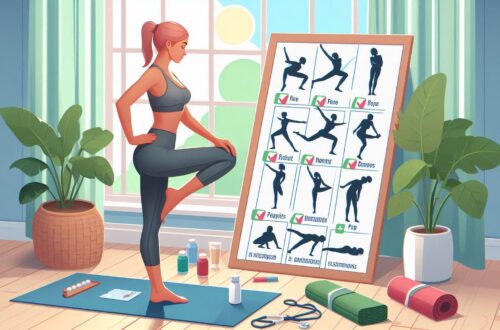Joint-friendly workouts are all about keeping your body moving without causing extra wear and tear on your joints. These workouts focus on balancing exercise with joint protection, so you get the health benefits without all the discomfort. They’re like a gentle nod to taking care of yourself while staying active.
When you’re doing joint-friendly exercises, you’re typically engaging in activities that avoid forceful impacts or repetitive stress on your joints. It’s about finding that sweet spot where your body stays active without causing harm.
This type of workout enhances your joint flexibility and strength, cutting down the chances of injuries or joint pain. As you work out, you’re not just preserving your physical health, but you’re also boosting your mental well-being. The good vibes from exercise are real! Plus, it keeps joint-related issues at bay, offering that long-term health benefit.
Consider low-impact activities like cycling, walking, or doing some stretches that not only safeguard your joints but also give your cardiovascular system some love. These exercises may seem mild, but trust me, they pack a punch when it comes to health benefits. They’re perfect for keeping you fit without putting too much pressure on those precious joints.
The Best Exercises for Joint Health: Safe and Effective Options
Taking care of your joints while staying active isn’t just wise; it’s crucial for keeping your body in great shape. One of the keys to happy joints is choosing exercises that are gentle yet effective. Consider this: your body is happiest when you’re moving, but not at the cost of sore or overworked joints.
Low-impact exercises are top-notch when it comes to joint health. Swimming is often a favorite since the water supports much of your body weight, allowing you to exercise without taxing your joints. Aquatic exercises give you a refreshing workout while being kind to your knees and hips.
Another gem in the world of low-impact fitness is cycling—whether you’re on a stationary bike or pedaling through nature, your joints will thank you for the smooth ride.
Yoga and Pilates are also rock stars in the joint-friendly exercise universe. Not only do they increase flexibility and strength, but they also promote body awareness. These practices teach you how to move in ways that prevent joint strain and build core stability. Imagine stretching and strengthening without the harsh impact; that’s the magic of these exercises.
Walking, an underrated hero, is easy on the joints while boosting your cardiovascular health. It’s as simple as lacing up your sneakers and hitting the pavement. Plus, walking outdoors adds the bonus of soaking up some Vitamin D from the sun. Now, if you’re wondering about the best exercise for joints—hint: it’s any activity you enjoy that’s easy on your body and keeps you moving consistently.
Explore different exercises and find what suits you best. What matters most is that you listen to your body and choose activities that make you feel good inside and out. Keeping your joints happy will contribute to lifelong health and mobility. It’s all about smart choices and staying active the right way.
Managing Joint Pain: Can I Still Exercise?
Dealing with joint pain can make you second guess your fitness routine, but hanging up your sneakers isn’t the answer. Instead, it’s about adapting your workouts to cater to how your body feels on a given day. Exercising with joint pain is possible with some care and attention.
- Listening to your body is key—if something hurts more than it should, it’s okay to stop or adjust. Keeping movements gentle and within your comfort zone keeps pain in check while still giving you the benefits of exercise. Focus on workouts that promote mobility and strength without adding stress on painful joints.
- If you’re iffy about what your joints can handle, having a quick chat with a healthcare professional shines a light on safe exercise options for you. They can give personalized advice and might even suggest physical therapy exercises perfect for maintaining health without the added pain.
- Now, pain management is part and parcel of exercising when joints feel cranky. Simple strategies, like applying a warm compress before working out and icing afterward, can make a world of difference. Over-the-counter pain relievers can also be a friend—just remember to use them judiciously.
- Pair up with low-impact exercises like swimming or stationary cycling to keep things gentle. These activities allow muscle build-up and boost cardiovascular health without pressuring your joints. You get the best of both worlds—staying active while keeping discomfort at bay.
- Remember, having joint pain isn’t the end of the road. It just means tuning in to your body’s signals and letting those guide your exercise choices. With the right approach, managing joint pain and exercising can go hand in hand.
Exploring No-Knee Exercises: Staying Active Without Strain
Working out without putting pressure on your knees might seem like a challenge, but there are plenty of smart options out there.
Let’s explore how you can stay active without involving those sensitive joints too much.
Aquatic exercises are once again up there as a fantastic choice. Water naturally supports your body, letting you move freely while keeping the knees out of the hard work. Swimming or water aerobics transforms into a fun way to maintain fitness without a hint of strain.
For those days when getting into the water isn’t an option, chair exercises step up as your trusty allies. These exercises focus on upper body and core, making them perfect alternatives that avoid knee engagement. Strength training with resistance bands or light weights can also be tailored to skip knee use yet still offer an intense workout.
Looking to add more variety? Think rowing machines! They offer a full-body workout, especially for the arms and back, with minimal knee involvement. It’s a high-caliber way to get your sweat on without knee strain.
Don’t forget about flexibility routines like seated yoga or tai chi, focusing on gentle stretches and movements that keep you limber and relaxed. These practices help improve balance and coordination while respecting your knees.
It’s all about being inventive and making use of exercises that cater to your body’s needs. Every little bit counts, and these options let you exercise with confidence, ensuring your joints stay as happy as the rest of you.
Building a Sustainable Joint-Friendly Workout Plan: Your Path to Lifelong Mobility
Crafting a workout plan that keeps your joints happy while also delivering fitness results takes a bit of thought, but it’s completely doable.
Start by recognizing your personal limits and needs. Everyone’s different, so tailoring a plan that’s right for you is essential.
Balancing various types of exercise is crucial. Mixing up cardio with strength training, flexibility, and balance exercises ensures a comprehensive approach that protects your joints. You’re not only improving your overall health, but you’re also preventing boredom. Keeping your routine exciting boosts motivation.
Consistency is the secret ingredient to success. Establish a workout schedule that’s realistic with your lifestyle. Whether it’s four to five times a week or just a couple of times when you can squeeze it in, the key is regularity without overdoing it. Giving some rest days is vital to prevent undue stress on those joints.
Progressive adaptation means gently increasing the intensity as your strength and endurance improve. Don’t rush it – slow and steady is the name of the game. This ensures your body adjusts without overwhelming your joints.
Check in periodically with a healthcare professional or a fitness coach. They provide insights that help tweak your plan, making sure it stays effective and suitable as you advance.
AND Remember to focus on what your body can do rather than what it can’t. Celebrate the milestones, no matter how small.
Joint-friendly workouts aren’t just about now – they’re about ensuring you’ve got the energy and mobility for all the things you love, long into the future.






